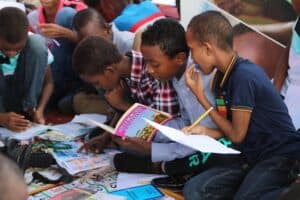Education in the 21st century is rapidly evolving to cater to the changing needs and demands of learners. As educators, it is vital to optimize classroom instruction to meet the unique requirements of 21st-century learners. This comprehensive guide aims to provide teachers with valuable insights and strategies to create an engaging and effective learning environment for their students. By incorporating personalized learning, technology integration, critical thinking, collaboration, and creativity, teachers can optimize their instructional practices and empower students to thrive in the digital age.
To effectively optimize classroom instruction for 21st-century learners, it is important to understand their characteristics and needs. Today’s learners exhibit diverse learning styles and preferences, emphasizing the necessity for differentiated instruction and individualized learning experiences. Furthermore, they are often referred to as digital natives, meaning they are accustomed to technology and possess a high level of technology literacy. These learners also place great value on critical thinking, collaboration, and creativity.
Personalized Learning
Personalized learning is a key strategy for optimizing classroom instruction. It involves tailoring instruction to meet the individual needs and interests of students. By building relationships and getting to know their students, teachers can implement a student-centered approach that promotes learner autonomy and self-directed learning. This approach encourages students to take ownership of their education and allows teachers to assess student progress and adjust instruction accordingly.
Technology
Technology integration is another crucial aspect of optimizing classroom instruction for 21st-century learners. By leveraging technology tools, teachers can enhance their instructional practices and engage students in meaningful ways. Blended learning and flipped classroom models combine traditional face-to-face instruction with online resources and digital content, promoting active learning and student engagement. Teachers can also utilize technology to teach digital citizenship and online safety, equipping students with essential skills for the digital world.
Critical Thinking Skills
Critical thinking is a fundamental skill for 21st-century learners. Teachers can design inquiry-based learning experiences that stimulate students’ curiosity and encourage them to ask questions and think critically. By incorporating problem-solving and decision-making activities into their instruction, teachers can foster higher-order thinking skills and equip students with the ability to analyze and evaluate information effectively. Scaffolding and guiding student thinking play a crucial role in helping students develop their critical thinking skills.

Collaboration is a skill that is highly valued in the 21st-century. Teachers can foster collaboration by implementing cooperative learning and group work strategies. Project-based learning provides opportunities for students to work together and develop teamwork skills. By creating a collaborative classroom culture and utilizing technology for collaborative tasks, teachers can prepare students for the collaborative nature of the modern workplace.
Creativity
Creativity is another essential skill for 21st-century learners. Teachers can cultivate creativity by creating opportunities for self-expression and providing artistic and imaginative activities. Design thinking and innovation can be integrated into the curriculum to foster creative problem-solving skills. Encouraging diverse perspectives and ideas allows students to explore their creativity and develop innovative solutions.
Assessments
Assessing 21st-century skills requires a shift from traditional assessment methods. Authentic and performance-based assessments provide a more accurate measure of students’ skills and abilities. Using rubrics and criteria for evaluating skills allows for consistent and fair assessment. Portfolios and digital documentation can showcase students’ work and progress over time. Additionally, self-assessment and reflection help students become more aware of their strengths and areas for growth.
Professional development plays a vital role in optimizing classroom instruction. Teachers should stay updated with educational trends and research to enhance their instructional practices. Participating in professional learning communities allows for collaboration and sharing of best practices. Attending workshops, conferences, and webinars provides opportunities for professional growth and learning from experts in the field. Collaborating with colleagues and engaging in reflective practices can also contribute to continuous improvement in instruction.
In Conclusion
Optimizing classroom instruction for 21st-century learners requires an ongoing commitment to adaptability, creativity, and a student-centered approach. By understanding the unique characteristics of 21st-century learners and incorporating personalized learning, technology integration, critical thinking, collaboration, and creativity, teachers can create an engaging and effective learning environment that prepares students for success in the digital age.
Embracing personalized learning allows teachers to meet the diverse needs of their students. By providing individualized instruction and differentiated learning experiences, teachers can accommodate different learning styles and preferences. Building strong relationships with students and getting to know their interests and strengths enables teachers to tailor instruction to their specific needs, promoting a student-centered approach. This approach fosters learner autonomy and empowers students to take ownership of their education, leading to increased engagement and motivation.
Technology integration is a powerful tool for optimizing classroom instruction. By incorporating technology tools into their teaching, educators can enhance the learning experience and meet the digital expectations of 21st-century learners. Blended learning models combine traditional face-to-face instruction with online resources, allowing for flexibility and personalized learning experiences. Flipped classrooms shift the traditional instructional model by having students access content outside of class and using classroom time for collaborative activities and discussions. Online resources and digital content curation provide access to a wide range of educational materials, promoting self-directed learning and inquiry-based exploration. Additionally, teaching digital citizenship and online safety ensures that students are responsible and ethical users of technology.
Critical thinking skills are essential for students to navigate the complexities of the modern world. Teachers can design inquiry-based learning experiences that encourage students to ask questions, think critically, and explore multiple perspectives. By incorporating problem-solving and decision-making activities into the curriculum, teachers can provide opportunities for students to apply their critical thinking skills to real-world situations. Scaffolding and guiding student thinking through questioning techniques and providing feedback play a crucial role in developing students’ ability to analyze, evaluate, and synthesize information effectively.
Collaboration is a key skill for success in the 21st-century. Teachers can foster collaboration by implementing cooperative learning strategies and encouraging group work. Project-based learning provides opportunities for students to work together, communicate effectively, and develop teamwork skills. Building a collaborative classroom culture creates an environment where students feel safe to share ideas, respect diverse perspectives, and learn from one another. Technology can facilitate collaboration through online platforms and tools that allow for communication, brainstorming, and collaborative tasks, regardless of physical proximity.
As educators, we wholeheartedly believe that nurturing creativity is absolutely essential in preparing our students for the challenges and possibilities that await them in the 21st-century. Our goal is to create an environment that fosters and encourages creativity, where our students can freely express themselves, explore the realms of artistry, and engage in imaginative activities. We understand the importance of incorporating design thinking and innovation into our curriculum, as it empowers our students to think outside the box, develop groundbreaking solutions, and fully embrace the process of refining and perfecting their ideas. We also deeply value the richness that comes from embracing diverse perspectives and ideas, as it not only fuels our students’ creativity but also cultivates a vibrant culture of innovation within our classroom. Together, we embark on a journey of discovery, where creativity flourishes, boundaries are surpassed, and new horizons are explored.



